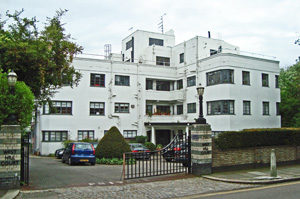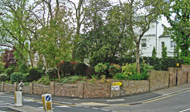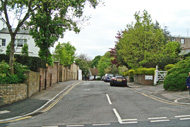for Officers
Military
In 1914 Herbert J. Paterson, Honorary Surgeon to the London Temperance Hospital, approached the War Office with a suggestion that he establish a hospital for seriously wounded officers in Highgate, where the air was cleaner and more conducive to healing, thus avoiding the need for amputations. The War Office turned down his request, but in the autumn of the same year Mr Paterson turned to the businessman, Sir Alfred Mond, Bt (1868-1930), who was impressed with the scheme. Purportedly, he considered the matter for two minutes and then agreed to it, before enquiring how much money would be needed.
Mond agreed to finance the project, donating £5,500 to set up the hospital and £700 a month to maintain it. He became the Chairman of the Hospital Committee, which also included four MPs. Queen Alexandra became its Patron and gave her name to the Hospital. Mr Paterson was appointed Honorary Surgeon and his wife became the Honorary Housekeeper.
A large private residence - Brookfield House - in Millfield Lane, Highgate, was acquired. Once the home of the Liberal politician Thomas McKinnon Wood (1853-1927), the 16-bedroom house had extensive grounds, in which was built a T-shaped wooden annexe to accommodate 20 patients.
The Army Council accepted the Hospital in March 1915. The house itself housed the administration offices, the operating theatre and the staff quarters, apart from one large room designated as the patients' rest room (its furniture, soft green in tone, loaned by Pryor and Part of Sloane Street). The Silent Electric Clock Co. of 192 Goswell Road loaned clocks, which kept the same time. Distributed throughout the Hospital, they ensured that staff had no excuse for unpunctuality. The kitchen was well-equipped, having a washing machine and rinser. Food was appetising and served on pretty china.
The annexe was designed so that the maximum amount of 8 hours possible sunshine could be obtained for the sick rooms. Each patient had his own room with a French window that opened onto a terrace, where beds could be wheeled out into open air and sunshine. Each room had electric lighting and a bell that could easily be reached by the patient. The bell rang in the corridor, where an indicator (a small red flag) was raised. Privacy for the patient was ensured by a red ticket being hung outside the door; a blue ticket indicated he was sleeping.
The wards were divided into blocks of four, with a nurse responsible for each. Apart from the Matron and Sister, the nursing staff consisted of 10 nurses, who wore a mauve uniform and received a salary equivalent to private work, some 2 guineas (£2.10) a week.
The ward doors were covered with cheap plain brown linoleum fastened with brass nails, thus making them easy to wash down, having no ledges or cracks. A large brass hook midway up the door enabled a nurse with her hands full to open and close it with the crook of her arm. The corridors were rendered noiseless by the floor covering of green linoleum padded thickly underneath with dried quilted grass.
The operating theatre had taps with long straight handles, which had cost 2s (10p)and enabled the taps to be turned on and off without contaminating the hands. The handles were covered with sterilised rubber tubing, which was kept in bowls and slipped on when required, after which it was returned to the sterilising solution.
Under the care of this Hospital, many patients retained the full use of their limbs which otherwise might have had to be amputated. Convalescent patients were sent to Melchet Court in Hampshire, the country residence of the Monds, which Lady Mond had converted into a hospital in August 1914 (their London residence in Lowndes Square had been opened to Belgian refugees).
Queen Alexandra visited in June 1915 and stayed for an hour and a half, talking to the patients. The garden was at its best, with the trees providing a feast of colour - lilacs, pink and white horse chestnuts, copper beeches and laburnums - and a peaceful environment.
In June 1917 an annexe opened at
25 Portland Place, for the reception of partially convalescent or less
seriously wounded officers. Donated by Mr S.J. Waring, it had 12
beds on the first floor, with ample accommodation for domestic and
nursing staff quarters, and sitting rooms and writing rooms for the
patients, as well as a winter garden.
By September 1917 the Hospital had been
extended to accommodate 33 beds. The average length of stay was
32.5 days and the average cost per officer was £31 9s 6d
(£31.48) (In March 1917 the cost per day was 18s 2d
(£0.91), reduced to 14s 11d (£0.85) by September).
The total maintenence expenditure of the Hospital for the year
was
about £13,800.
The Hospital treated some 839 of the most seriously wounded officers (of whom only 8 had died), including the poet Robert Graves, whose death had been prematurely reported in The Times in 1916. (The Times later apologised, putting an announcement in the Court Circular. Graves received a letter from its advertising manager, informing him that he would not be charged for the announcement that he had not died of his wounds.)
The Hospital closed on 23rd July 1919. A concert and entertainment was held at 9 o'clock in the evening, with the music supplied by the string band of H.M. 1st Life Guards. This was followed by dancing in the Princess Victoria Ward until the early hours of the morning. The patients presented Mr and Mrs Paterson with a 200-year-old oak dining table, while the Matron, Miss Mary Sinzininex, received a set of furs.
The Hospital building was demolished in 1934 and West Hill Court, an apartment block, now occupies the site.

West Hill Court.


Looking up Millfield Lane from West Hill.
(Author unstated) 1917 Queen Alexandra's Hospital for Officers: opening of annexe. British Medical Journal 1 (2946), 820-821.
(Author unstated) 1917 Queen Alexandra's Hospital for Officers. British Journal of Nursing, 5th June, 480.
(Author unstated) 1917 Queen Alexandra's Hospital for Officers, Highgate. British Journal of Nursing, 29th September, 199-200.
Denford S, Hayes DA 2007 The Streets of Highgate. London, Camden History Society.
http://rcnarchive.rcn.org.uk (April 1915)
http://rcnarchive.rcn.org.uk (December 1917)
www.collectnobel.com
www.tlemea.com
Return to home page